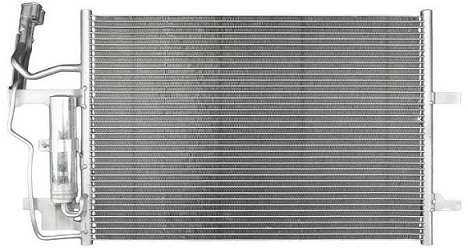![]()
Car Air Conditioner not Blowing Cold Air? Here are 6 Solutions
DISCLAIMER: AS AN AMAZON ASSOCIATE I EARN FROM QUALIFYING PURCHASES. THIS POST CONTAINS AFFILIATE LINKS THAT WILL REWARD ME MONETARILY OR OTHERWISE WHEN YOU USE THEM TO MAKE QUALIFYING PURCHASES. FOR MORE INFORMATION, PLEASE READ MY EARNINGS DISCLAIMER.
|
When the air conditioner inside your car stops working, the most common problem is the low refrigerant level (due to winter inactivity). If your air conditioning is blowing hot air instead of cool air, your condenser could be clogged and needs cleaning.
As the summer heat marches ever closer, many of us will be getting ready to blast the air conditioning in our cars to keep ourselves cool. One of the most depressing discoveries we can make in the sweltering months starting in late June is that our A/C is NOT doing the one thing we demand of it, and that is:
Blowing cold air!
If your car’s air conditioning seems to be working, but it is NOT blowing any cold air, then there are three main explanations:
- You’re experiencing a mechanical problem.
- There are electrical problems to be resolved.
- There’s a leak somewhere.
In this article, we’ll be diving in more deeply to discover all the biggest factors behind your car’s A/C not blowing cold air as it should. It will hopefully help explain why you’ve been experiencing these problems.
Before I will go over the three main areas mentioned in the introduction in a bit more detail, we should be clear on just what we’re dealing with. There are 5 major components in your car’s A/C system:
- The compressor. Pressurizes the refrigerant (gas), and pushes it to the condenser.
- The condenser. It can be found in front of the radiator; reduces the gas temperature, keeps the pressure of the system, and turns the refrigerant from its gaseous state to a liquid that flows to the receiver/dryer.
- Receiver/Dryer (or accumulator). If your car has a thermal expansion valve, then it will have a receiver/dryer; if it has an orifice tube, then you have an accumulator; it separates gas from liquid and stops liquid from getting into the compressor.
- The thermal expansion valve (or orifice tube). Which one you have depends on your car (see above); located between condenser and evaporator; tracks the amount of pressure and temperature in the system, allowing it to calculate exactly how much refrigerant is safe to put into the evaporator.
- The Evaporator. It’s located on the inside of your car, evaporates the refrigerant that comes from the “high-pressure zone” turning the liquid into a very cold gas; this process extracts the heat from the inside of your car, completing the cooling process.
Now let’s look at the three main explanations for problems with A/C units when they are not blowing cold air. We’ll start with the most common one: “mechanical problems”.
Mechanical problems
Your car’s engine and connected systems are a mass of individual moving parts, all of which need to be working properly if the car is to function the way you want and expect. Very often, any problem with a car’s system (including A/C) is caused by an individual part not working properly.
#1. The refrigerant is in need of a recharge
Finally, a very common cause of a lack of cold air in the A/C system is that there is not enough refrigerant in the circuit. This can be easily solved with a recharge of refrigerant.
Since the A/C or your car is a closed system, it’s very important that when you get a recharge you check for any major leakage on the circuit, to avoid having to refill your system in the short future.
#2. The fan motor isn’t working
The fan motor can be found at the front of your car’s motor. Your car might have multiple fans, but if even one of them isn’t working properly, then its cooling capacity will be reduced. The fan motor isn’t one of the five integral parts of the A/C system, but its failure means that the entire engine area can start to overheat, rendering the A/C system less effective.
It’s a similar effect to what happens when the cooling fan on your laptop isn’t working properly.
#3. You have a blocked or broken condenser
As I mentioned above, the condenser has the vital role of reducing the temperature of the refrigerant and moving the refrigerant to the receiver/dryer or accumulator. Sometimes the condenser can get blocked by debris accumulated on the car’s front grille, and if it does, then it won’t perform its’ vital function.
In this case, the refrigerant will be overheated and you’ll get a thoroughly unpleasant blast of exclusively warm air. Fortunately, the condenser is usually found in a prominent location at the front of the engine area, which makes any problem quite visible.

Furthermore, since the debris is on the grille, you can simply remove it by hand or rinse it off to allow the condenser to work again. If you check for blockages but find none, then it could be an indication that something more serious has happened to the condenser.
Open the hood of your car and check to see if there are any visible signs of damage like punctures. If the grille is not blocked up, it’s possible that a piece of debris came clean through the grille and damaged this key A/C component.
If you see the damage, the condenser will need replacing. Unfortunately, this is one part that you can’t simply patch up and continue. Here is a video on how to check your A/C condenser:
#4. The “blend air door” is stuck
The blend air door is a small hatch in the ventilation system that opens up once you switch the environment settings from heat to cold. Once open, the ventilation system can draw in the cooled air and bring the internal temperature of the car down.
If this hatch is stuck or unable to open for some reason, then the system will continue to only bring in warm air from the engine, thus a distinct lack of cooling.
#5. The compressor is not working properly
Those of us who live in low-temperate zones could go for many months at a time without using our car’s air conditioner. Believe it or not, protracted periods of idleness can cause the compressor to “go bad” and then it won’t perform properly.
If this happens, you’ll need the help of a mechanic, but there are things you can do to prevent this. The best thing to do is run the A/C system at least once every few weeks just for 10-15 minutes or so.
This will ensure the parts keep their integrity and will be ready for their heavy-duty summer use. Here is a nice video on how to find out if there is something wrong with your A/C compressor“:
#6. The expansion valve is clogged
If you have a bad or clogged expansion valve, the A/C system of your car will fail to function, in most cars, this can be checked very fast and, if that’s the case of the malfunction, you just need to replace it with a new one.
This can be done in a DIY job for anyone in the know, but you shouldn’t feel bad about asking a mechanic to do this. Refrigerant is an unsafe chemical, so it’s understandable to leave it entirely in the hands of professionals.
Electrical Issues
The car’s electrics are among the most daunting areas to fix, chiefly because they are so hard for the layman to diagnose. It’s not as though you can just pop open the hood and take a quick look to see if the electricity is okay.
What you can do, however, if you know where to look, is to try to check for any signs of frayed or damaged wiring and any blown fuse. This should be a purely visual inspection. Do not take risks by touching or attempting to mend any wiring yourself, unless you’re qualified to do so.
The other possibility is that the wiring itself is alright, but another part of the electrical system is malfunctioning. This is likely to be the case when there are no other signs of physical or mechanical damage (as mentioned in “Explanation 1.”)
When you press the A/C button, pay attention to a clicking sound, that sound is the typical indicator that the compressor’s clutch is engaging. If you don’t hear that sound, it’s probable that you are experiencing a problem with the A/C system relays, lack of gas pressure, or a failure of the compressor clutch itself.
The following video will explain how to diagnose automotive electrical problems:
There’s a leak somewhere
And now, we come to the other possibility, which is that your A/C system is leaking a key fluid, probably its refrigerant, R12 gas on cars prior to 1995 and R134a on newer cars. Any leak in your car’s engine is a red flag that warrants the professional attention of a mechanic.
Just as nothing should be making unsettling grinding noises, or rattling uncontrollably, nothing should be leaking fluids. A leak in your A/C system may be so slow as to be imperceptible to a quick visual inspection.
You may not notice any visible pooling of liquid, and that means that all of the system’s many pipes, hoses, and other components need to be checked through carefully, and replaced if need be. If there is no visual evidence of a leak, you can check by spraying a mixture of water and detergent or using “ultraviolet leak dye”:
Special systems need professional attention
The amateur mechanic may relish the opportunity to get stuck in and try to fix problems like a faulty air conditioning system. There are significant risks, however, and we encourage anyone experiencing the issues we have described above to seek the help of a trained mechanic.
Why do we say this?
- Exposure to toxic chemicals. The key refrigerant that makes the system work is a toxic and dangerous chemical that needs to be handled with care. Professionals know how to deal with it safely, and are best placed to sort out the problem.
- Tampering could void the warranty. Like other systems in modern cars, air conditioning systems are becoming increasingly sophisticated and sensitive to tampering. As the level of technical difficult rises, so too does the level of expertise required to tend to them.
- The complexity of the system. Tinkering may cause more damage than good. Moving on from the point above, whenever we mess with sensitive and complex systems, we run the risk of causing more damage than was there in the first place. More damage just means more time and money wasted trying to get the car back to normal.
Given the risks, I recommend always seeking professional assistance when you are experiencing problems with your air conditioning system, or other parts of your car.
Stay safe and enjoy that cool A/C breeze… If your A/C is not getting any better, see the map below:
Attention! This article is for informational purposes ONLY and is NOT a replacement for professional advice! ALWAYS consult your local specialist for an appropriate solution to your problem. All statements, prices, contact information, recommendations, and reviews contained herein came from sources that we believe to be reliable, but the accuracy or completeness thereof is not guaranteed. Please contact the service provider for complete details and updates.



